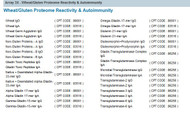Gluten Antibody Testing
Posted by DS DC on Feb 16th 2022
Cyrex Labs Array 3
Array 3 is an antibody test of 12 different proteins related to wheat and wheat gluten. Most labs will test 2 or 3 proteins and then only IgA or IgG. Cyrex tests for both IgA and IgG bringing the total to 24 tests. Another important Cyrex contribution was developing a system to test for all these antibodies for the price of one antibody test with previous systems. This panel was developed to better predict who can benefit from a gluten-free diet (GFD) as many people who find a GFD necessary test negative on all other standard profiles. With this type of testing a yes means yes and a no means maybe. Sometimes a person will still be clinically reactive to a protein but the testing will still be negative. Also if you have been gluten free for more than a few weeks, the test becomes less and less reliable.
Blood AntiBody Alternative
An alternative to blood testing is antibody testing of the stool as many of these antibodies are actually made in the intestines. Stool testing of antibodies tends to stay active for many months after starting a GFD. Enterolab has developed gluten sensitivity tests as well as genetic testing to help people trying to sort out their gluten status.
What Do The Results Mean?
Equivocal means one standard deviation from normal and out of range means more than one standard deviation from normal. Therefore equivocal is still positive, just a milder reaction than out of range.
Q&A Section
Q: What if only one test is equivocal and the other tests are within normal range. Am I still gluten sensitive? A: Yes. Positive is positive. Your body is still reacting to gluten. It is difficult to predict how extensive the clinical damage will be based on any lab test. Remember “yes" means “yes" and “no" means “maybe" in this context.
Diagnosis for most conditions is a looking at lab tests plus clinical presentation.
Q: Is IgG is a significant finding even without elevated TTG?
A: Short answer is “yes". Different tests are being developed to better align lab testing with other diagnostic and clinical diagnosis results. The lab scientists have learned that just testing for reactivity to tissue tranglutaminase in different forms (2,3 and 6) is not as good as testing that AND the gliadin-transglutaminase complex.
Q: I know it's using Standard Deviation to determine low, medium, high, but what unit of measure is the actual number?
A: ELISA results are not numerical but color-codes responses to enzymatic reactions that are matched to an index. Wikipedia has a good discussion.
Q: Does >4 for Gliadin IGG mean they don't report the actual number once it reaches 4?
A: Short answer is yes. The sensitivity of the test has hit the maximum color response. See Wikipedia discussion on ELISA.
Q: Does Native and Deamidated mean it's combined - I have heard about deamidated, but not native + deamidated.
A: Deamidated proteins have shown more accurate reactions to lab testing than native forms. Cyrex chooses to test both to be sure that any sensitivity in either form is recorded.
Comparative Usefulness of Deamidated Gliadin Antibodies in the Diagnosis of Celiac Disease. Clin Gastroenterol Hepatol. Apr 2008; 6(4): 426370. Shadi Rashtak et al.
